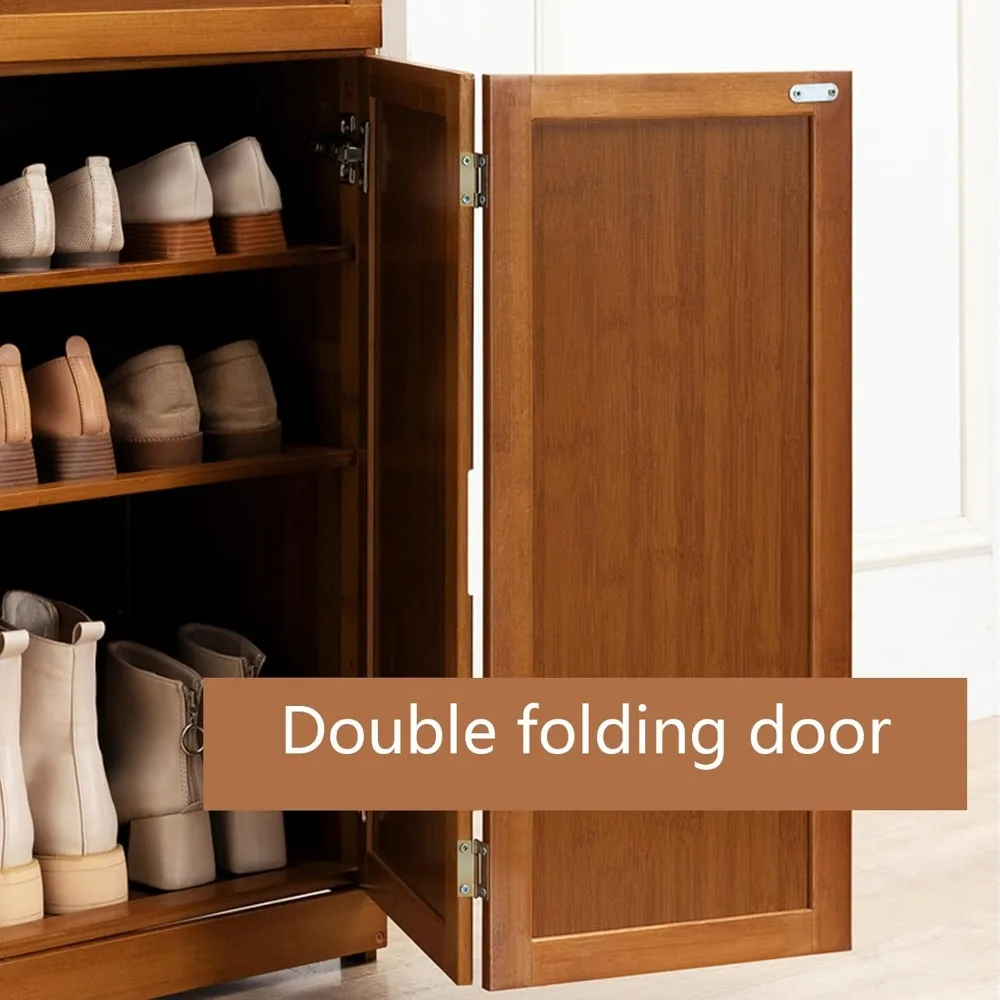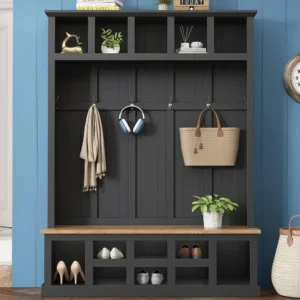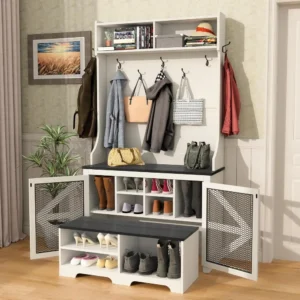Understanding Mudrooms and Entryways: Key Differences and Purposes
When designing your home’s entrance areas, understanding the distinction between mudrooms and entryways is crucial for creating spaces that are both beautiful and functional. These two areas serve different purposes and require thoughtful storage solutions tailored to their specific roles.
An entryway is typically the formal entrance to your home, usually located at the front door. It serves as the first impression for guests and sets the tone for your home’s aesthetic. This space prioritizes style and warmth while providing basic organization for everyday items.
A mudroom, on the other hand, functions as a transition zone between the outdoors and your living space, often located at a side entrance, back door, or garage entry. Its primary purpose is practical: to contain mess from outdoor activities and provide robust storage for a variety of household items.
Understanding the formal vs. functional entry spaces helps homeowners make better decisions when designing these critical areas. While both spaces involve storing similar types of items, they do so with different priorities and approaches.
Comparing Mudrooms and Entryways:
| Feature | Entryway | Mudroom |
|---|---|---|
| Primary Function | Creates welcoming first impression | Prevents outdoor mess from entering home |
| Location | Main front entrance | Secondary entrance (side door, garage) |
| Formality Level | Higher – designed for guests | Lower – designed for family functionality |
| Storage Focus | Minimal, decorative storage | Maximum, durable storage |
| Typical Items | Light coats, small accessories, keys | Sports equipment, heavy outerwear, boots, pet supplies |
| Design Priority | Aesthetics with functional elements | Function with aesthetic considerations |
While entryways focus on creating a stylish welcome, mudrooms emphasize organization and containment. Many homes benefit from incorporating solutions that combine storage with hanging space to maximize functionality in either type of entrance area.
Essential Components of Stylish Entryway Storage
Creating an inviting entryway requires thoughtfully designed storage that enhances your home’s aesthetic while providing practical organization. The key is finding balance—incorporating enough storage to keep the space tidy without overwhelming the area or detracting from its welcoming atmosphere.
Core Components for Entryway Organization
Console Tables and Decorative Chests
A well-proportioned console table serves as both a display surface and storage hub. Look for pieces with drawers for hiding small items like keys, sunglasses, and mail. Slimmer profiles (10-12 inches/25-30 cm deep) prevent narrow hallways from feeling crowded while still providing functionality.
Entryway Benches
Adding a seating element transforms how your entryway functions, creating a comfortable spot for putting on or removing shoes. The best options incorporate stylish solutions for entryway shoe organization with hidden compartments beneath hinged seats or open shelving below.
Wall-Mounted Hooks and Coat Racks
Strategic placement of hooks keeps frequently used items accessible without consuming floor space. Consider variations in height to accommodate both adults and children, and choose designs that complement your overall aesthetic.
Mirror Integration
Beyond their practical function for last-minute appearance checks, mirrors enhance entryways by reflecting light and creating the illusion of larger space. Pairing mirrors with storage elements maximizes their utility.
Mail and Key Organization
Small, dedicated organizers prevent these everyday items from creating clutter. Look for wall-mounted options with divided compartments that keep mail sorted and keys easily accessible.
Closed Storage Options
For entryways with available space, coat closets provide the ultimate hidden storage solution. Maximize their efficiency with tiered hanging rods, door-mounted organizers, and customized shelving for accessories.
When designing your entryway storage system, maintaining at least 36-48 inches (91-122 cm) of clearance ensures comfortable movement through the space. This becomes especially important when implementing compact storage options for entryways in smaller homes.
For materials, consider the balance between beauty and performance. While entryways don’t face the same moisture challenges as mudrooms, they still experience high traffic. Quality woods with protective finishes, metal accents, and durable upholstery fabrics provide the best combination of style and longevity.
Comprehensive Mudroom Storage Solutions for Maximum Organization
Unlike entryways that balance decoration with light storage, mudrooms are organizational powerhouses designed to handle everything from muddy boots to sports equipment. Their primary purpose is containment—keeping outdoor elements from spreading throughout your home—while providing substantial storage capacity for a wide range of items.
Essential Mudroom Storage Components
Built-in Cubbies and Lockers
The backbone of effective mudroom design, dedicated storage compartments provide each family member with their own space. Standard dimensions include:
– Width: 12-24 inches (30-61 cm) per person
– Depth: 14-16 inches (35-40 cm)
– Height: Varies based on ceiling height and storage needs
Dividing storage vertically creates zones for hanging items above and shoe storage below, maximizing organization in a compact footprint.
Heavy-Duty Benches
Mudroom benches need to withstand daily use while hiding away bulky items. The ideal height ranges from 16-18 inches (40-46 cm) for comfortable seating. Specialized storage solutions for footwear in mudrooms often incorporate ventilated compartments or pull-out drawers to contain dirt and allow wet items to dry.
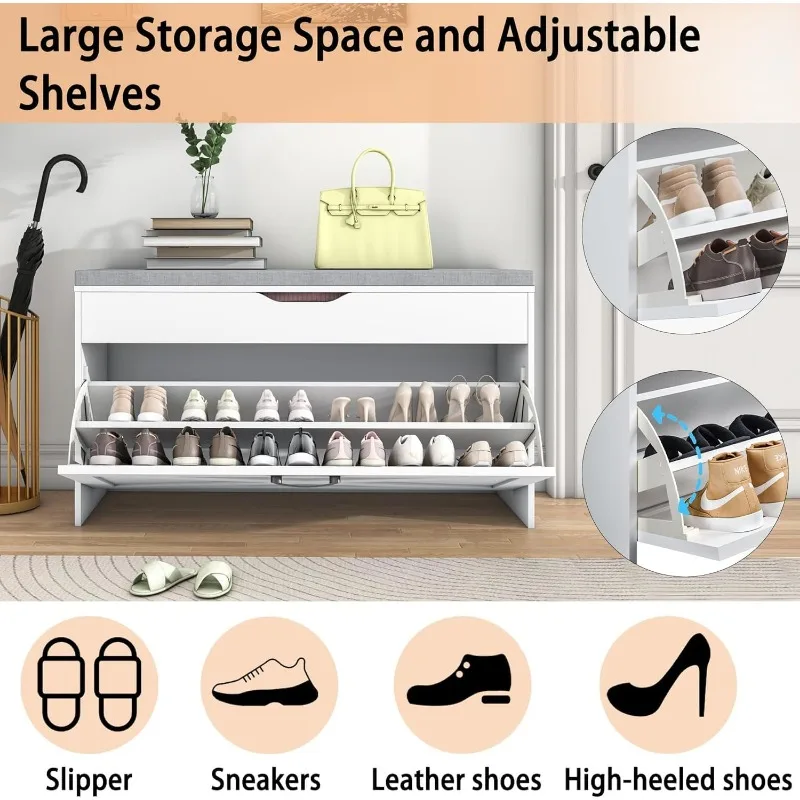
Wall Hook Systems
Installing robust hooks at varying heights creates versatile hanging storage:
– Adult coat height: 60-66 inches (152-168 cm)
– Children’s access: 36-48 inches (91-122 cm)
– Heavy-duty hooks for backpacks and sports bags
– Lower hooks for dog leashes and other pet accessories
Shelving Configurations
Both open and closed shelving play important roles in mudroom design:
– Open shelving: Provides visibility and accessibility for frequently used items
– Closed cabinetry: Conceals visual clutter and protects sensitive items
– Upper shelves: Perfect for seasonal or less frequently used items
– Lower shelves: Ideal for daily essentials requiring quick access
Specialized Storage Zones
Creating dedicated areas for specific categories of items enhances functionality:
– Footwear station with boot trays and drying racks
– Sports equipment zone with specialized hooks and bins
– Pet supply area with food storage and accessory organization
– Technology charging station for devices
For families with active lifestyles, seating options designed for high-traffic areas provide both comfort and durability in these hardworking spaces.
Material selection becomes critically important in mudrooms due to exposure to moisture, dirt, and heavy use. Opt for:
– Water-resistant flooring like tile, luxury vinyl, or sealed concrete
– Moisture-resistant cabinet materials and finishes
– Washable fabrics for any soft furnishings
– Rust-resistant metal components for hardware and hooks
Storage Philosophy: Aesthetic vs. Functional Approach
The fundamental difference between entryway and mudroom storage lies in their underlying philosophies. Understanding these contrasting approaches helps homeowners make informed decisions about how to design these critical spaces.
Entryway Philosophy: “Graceful Utility”
Entryway storage prioritizes aesthetic impression while incorporating subtle functionality. The goal is to create a space that feels welcoming and visually appealing while still addressing basic organizational needs. This philosophy manifests in several ways:
- Storage elements double as decorative pieces
- Organization solutions blend seamlessly with interior design
- Visual clutter is minimized through hidden storage
- Materials and finishes match the home’s overall style
- Fewer items are stored, but with greater intentionality
The entryway philosophy values the emotional impact of the space—how it makes residents and visitors feel upon entering—while still acknowledging the practical need for basic storage.
Mudroom Philosophy: “Functional Fortress”
Mudroom storage embraces a “function-first” mentality, prioritizing performance and containment above all else. While aesthetics aren’t abandoned entirely, they take a secondary role to practical considerations:
- Maximum storage capacity is the primary goal
- Specialized solutions address specific organizational challenges
- Durability trumps decorative elements
- Materials are selected primarily for performance
- Storage is often visible and accessible rather than concealed
These contrasting approaches influence everything from material selection to storage visibility decisions. Understanding the comparing visibility approaches in storage design helps homeowners make better choices about whether items should be displayed or hidden away.
The key to successful entry space design lies in honoring the distinct purpose of each area while creating a cohesive transition between outdoors and indoors. Even mudrooms benefit from thoughtful aesthetic touches, while entryways function better with practical organizational elements.
Assessing Your Home’s Needs: Which Storage Solution is Right for You?
Determining whether your home needs a dedicated mudroom, a formal entryway, or a hybrid solution begins with a thorough assessment of your household’s specific requirements. Consider these key factors when evaluating your entrance storage needs:
Household Composition and Lifestyle
- How many people live in your home?
- Do you have children who participate in sports or outdoor activities?
- Do you have pets that require special entrance accommodations?
- How many coats, shoes, and bags does your family use regularly?
Home Layout and Entrance Points
- How many entrances does your home have?
- Which entrance gets the most frequent use?
- Is there a natural separation between formal and casual entrances?
- How much square footage can you dedicate to entrance storage?
Regional Considerations
- What weather conditions impact your entrances most frequently?
- Do you need storage for seasonal items like umbrellas, sunscreen, or snow gear?
- How much dirt and moisture typically enter your home?
Finding solutions for limited entry spaces often requires creativity and careful planning. Even compact areas can incorporate essential storage elements when properly designed.
For families with children, implementing specific needs of households with children becomes particularly important, as these households typically require more robust storage systems and lower-height accessibility.
When assessing budget considerations, remember that entry storage can range from simple furniture additions to complete built-in systems:
– Furniture pieces: $100-$500 per item
– Basic built-in systems: $1,000-$3,000
– Custom comprehensive solutions: $3,000+
The investment should reflect both your immediate needs and long-term plans for the home, as well-designed entrance storage adds both functionality and potential resale value.
Creating Hybrid Solutions: When You Need Both Functions in One Space
Many homes lack the space for both a dedicated mudroom and a formal entryway. Fortunately, with thoughtful design, a single space can effectively serve both purposes. The key lies in strategic zoning and multi-functional furniture selections.
Zoning Strategies for Dual-Purpose Entrances
Creating visual separation helps distinguish between formal and functional areas:
- Use flooring transitions to define different zones (tile for high-traffic areas, more decorative flooring elsewhere)
- Employ color blocking to visually separate functional storage from welcoming areas
- Install partial walls, room dividers, or strategically placed furniture to create distinct spaces
- Utilize lighting to highlight different functional zones
Multi-Functional Furniture for Combined Spaces
The right pieces can address both aesthetic and practical needs:
- Storage benches that offer seating while concealing shoes and seasonal items
- Hall trees that combine coat storage, seating, and decorative elements
- Console tables with hidden organizational features beneath stylish exteriors
- Wall systems that incorporate both open and closed storage in an attractive package
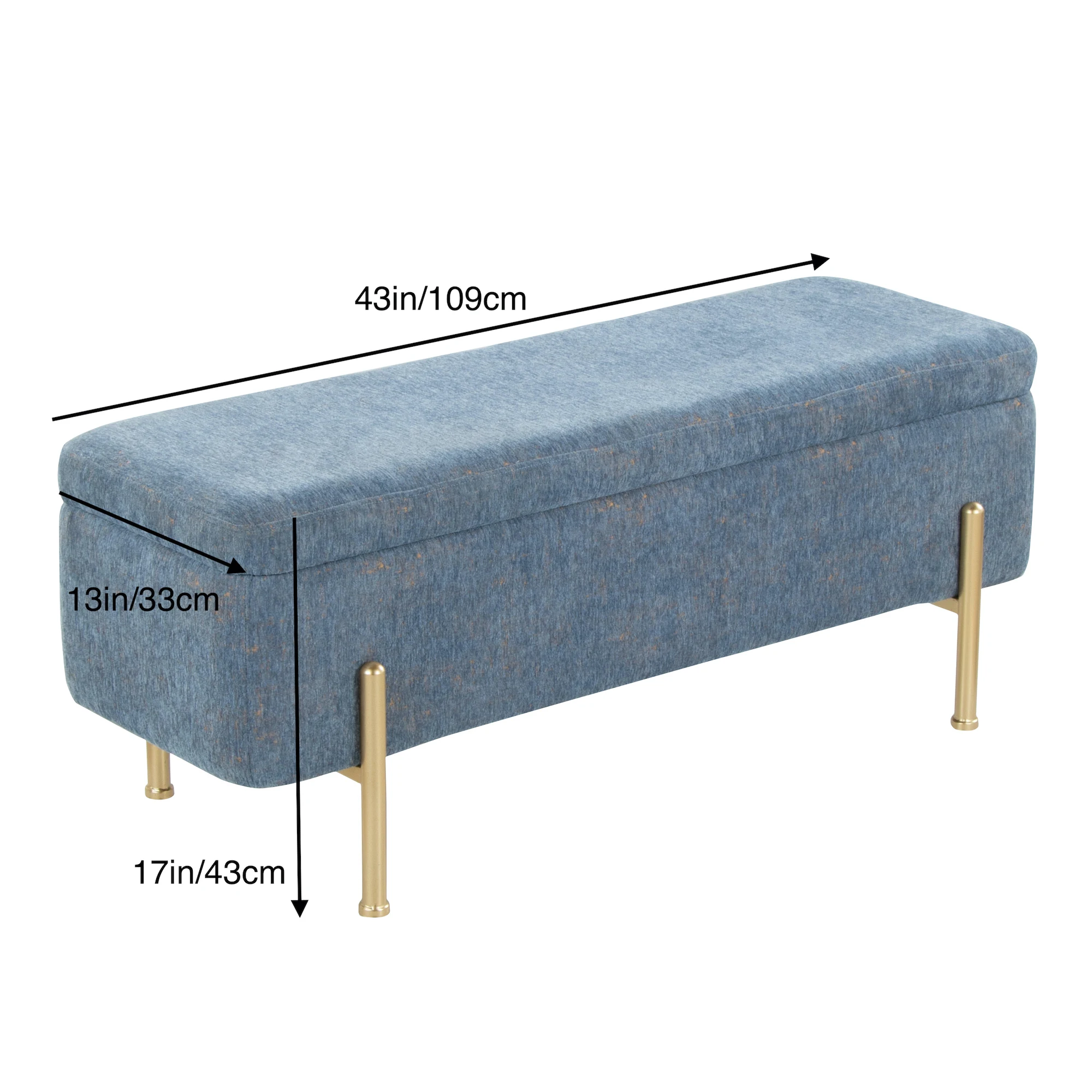
For homes with limited square footage, versatile storage options for combined spaces provide solutions that maximize functionality without overwhelming the area. Look for pieces with adjustable components that can be reconfigured as your needs change.
One effective approach is creating a “mudroom moment” within a more formal entryway. This might include:
- A designated boot tray tucked beneath a decorative bench
- Attractive hooks mounted on a small section of wall
- A stylish cabinet with internal organization for sports equipment
- Water-resistant materials in high-traffic areas that still complement the overall design
By thoughtfully blending practical storage with aesthetic elements, even compact spaces can successfully serve both functions while maintaining a cohesive look.
Pro Organization Tips for Maximizing Any Entry Space
Regardless of whether you have a dedicated mudroom, formal entryway, or combined space, certain organizational principles can dramatically improve functionality. These strategies help create systems that not only look better but actually work better for daily life.
1. Implement the “One In, One Out” Rule
For entry spaces that tend to accumulate clutter, establish a policy where adding a new item means removing something else. This is particularly effective for seasonal items like coats and accessories.
2. Create Storage Zones Based on Frequency of Use
Organize items in three tiers:
– Daily use: Positioned at eye level with easy access
– Weekly use: Stored in secondary positions that may require reaching
– Seasonal use: Placed in less accessible storage until needed
3. Utilize Vertical Space Strategically
Most homeowners underutilize the vertical potential of their entry spaces:
– Install hooks and organizers at varying heights
– Use stackable containers that can grow with your needs
– Consider ceiling-mounted storage for rarely used but necessary items
4. Incorporate Hidden Storage Throughout
Some of the most effective storage solutions are the least visible:
– Hollow bench seating with lift-top access
– Wall panels that flip down to reveal shallow storage
– Drawer dividers within console tables to maximize organization
Finding ways to organize high-traffic entry areas often requires thinking beyond conventional furniture arrangements. Consider unexpected solutions like repurposing kitchen organizers for mail sorting or using shower caddies for small accessories.
5. Establish Daily Reset Routines
The most beautiful storage systems fail without consistent habits:
– Implement a five-minute evening reset routine
– Create simple systems that all family members can maintain
– Use labeled containers to make organization intuitive
– Design storage that works with natural behavior patterns rather than against them
By combining these organizational strategies with thoughtfully designed storage furniture, you can transform even challenging entrance areas into functional, beautiful spaces that enhance daily life.
Nested Goods Storage Solutions for Entryways and Mudrooms
At Nested Goods, we understand that entrance storage requires a special balance of durability and design. Our collection focuses on multi-functional pieces that transform these transitional spaces while maintaining the aesthetic integrity of your home.
Our approach centers on the philosophy that entrance furniture should work twice as hard as other pieces in your home. Each design incorporates hidden storage compartments, modular components, and thoughtful details that address specific organizational challenges.
The materials we select reflect this dual commitment to beauty and performance. We use:
– Solid hardwoods with protective finishes that resist scratches and moisture
– High-quality hardware designed for thousands of open-close cycles
– Performance fabrics on upholstered elements that clean easily
– Engineered components that withstand daily use

Our designers pay particular attention to the details that make entrance storage truly functional:
– Properly sized compartments for common items like shoes, bags, and accessories
– Weight distribution engineering to prevent tipping when fully loaded
– Ventilation in closed storage to prevent odor buildup
– Soft-close mechanisms to protect fingers and reduce noise
For homes with challenging layouts, our space-efficient solutions for challenging layouts make use of often wasted corner spaces, transforming them into valuable storage opportunities.
Coat Rack Shoe Bench, Corner Entryway Bench, Corner Hall Tree, Shoe Bench for Entryway
$313.58 Select options This product has multiple variants. The options may be chosen on the product pageShoe Storage Bench for Entryway
$459.02 Select options This product has multiple variants. The options may be chosen on the product pageCorner Entryway Bench, Entryway Bench with Cushion, Modern Entryway Bench, Shoe Bench for Entryway
$476.34 Select options This product has multiple variants. The options may be chosen on the product pageBench with Hooks and Storage, Entryway Hall Tree, Mudroom Bench with Cubbies, Mudroom Bench with Shoe Storage
$818.38 Select options This product has multiple variants. The options may be chosen on the product pageEntryway Coat Rack Bench, Entryway Hall Tree, Farmhouse Mudroom Bench, Mudroom Bench with Shoe Storage
$805.09 Select options This product has multiple variants. The options may be chosen on the product pageBench with Hooks and Storage, Entryway Coat Rack Bench, Entryway Hall Tree, Mudroom Bench with Shoe Storage, Mudroom Coat Rack Bench
$793.73 Select options This product has multiple variants. The options may be chosen on the product page
When selecting entrance storage, remember that these pieces face more demands than almost any other furniture in your home. Investing in quality construction pays dividends through years of reliable service and enduring style.
Final Thoughts: Creating a Welcoming and Organized Entry Experience
The distinction between mudroom and entryway storage reflects a deeper understanding of how we move between outdoor and indoor living. While they serve different purposes—one primarily functional, the other more aesthetic—both spaces play critical roles in creating homes that work well for modern life.
Whether you implement a dedicated mudroom, a stylish entryway, or a hybrid solution, thoughtful storage design transforms daily routines. The simple act of having a designated place for everyday items reduces stress, saves time, and creates a more pleasant living environment for everyone in the household.
The most successful entrance spaces reflect the specific needs and habits of the people who use them. Rather than following rigid design rules, focus on creating systems that work with your family’s natural patterns and behaviors. The best storage solutions are those that become so intuitive they’re almost invisible in daily use.
As you plan your entrance areas, consider how combining functionality with comfort in entry design creates spaces that truly enhance quality of life. The right balance of practical storage and welcoming aesthetics doesn’t just organize your belongings—it sets the tone for your entire home experience.
With thoughtful planning and quality components, your home’s entrances can become more than just transitional spaces—they become the foundation for organized, beautiful living that begins the moment you step through the door.

